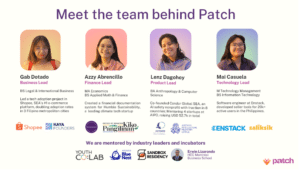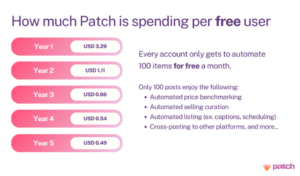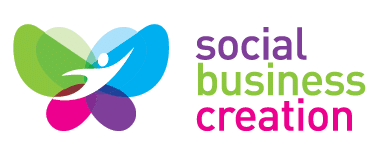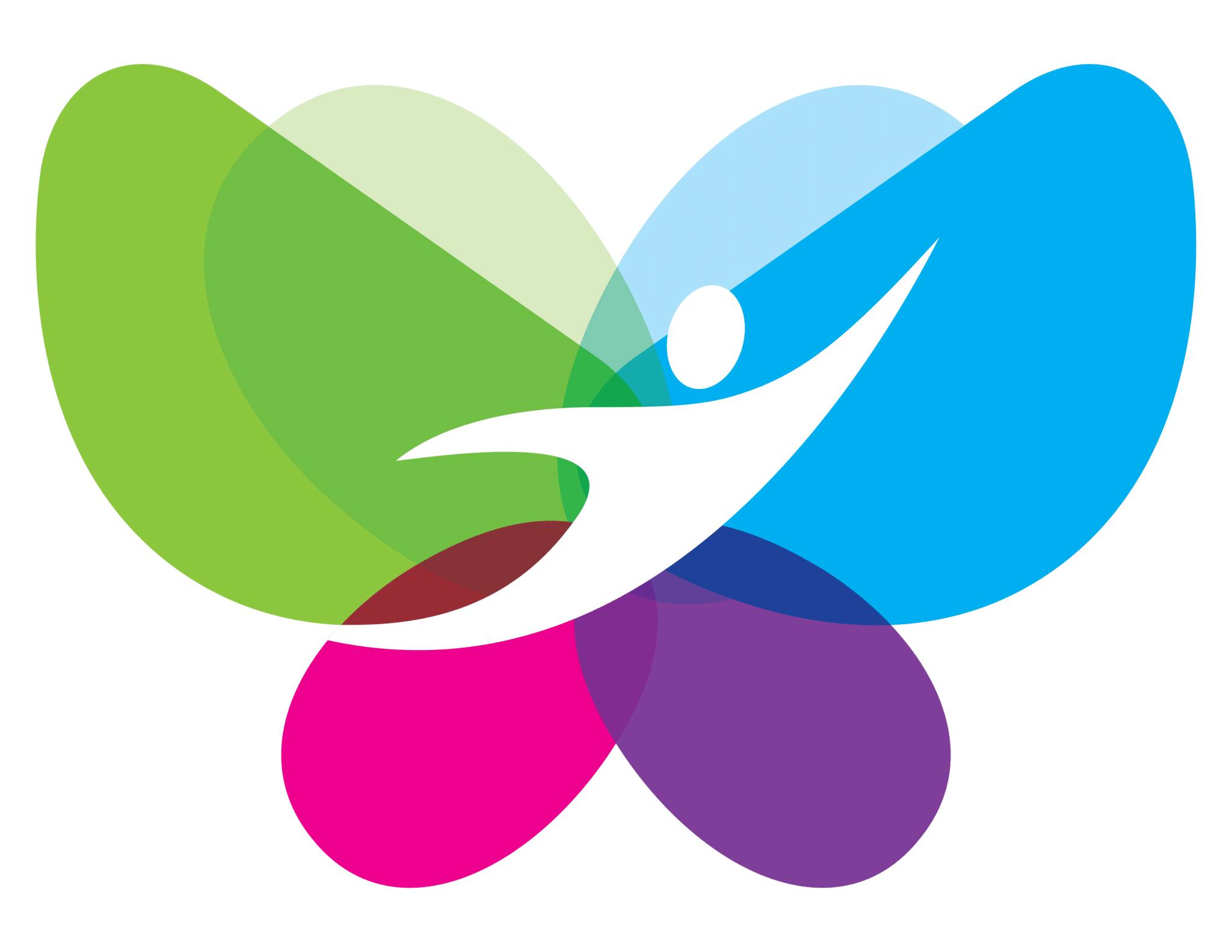BUSINESS MODEL INNOVATION
Business Model Innovation
To access our pitch and also to check the documentation from our fieldwork, kindly proceed to this link.
A. Social business design
A1. Social mantra one-liner
A smart marketplace for circular fashion
A2. Production/ service presentation
We have established a connection with a few sellers who agreed to be part of our beta testing by Q4 2024. The following conversations were exchanged between Patch and the sellers.
Additionally, the team was able to present their product in front of possible users and receive immediate feedback from the audience in their Sandbox student challenge.
We have also launched our landing page and gathered feedback from the sellers who joined our signups.
The team was able to present in front of experts about the product in the Hult Prize competition. We were able to receive immediate feedback from them.
Our team went on fieldwork in a physical pop-up in Makati, Philippines where they were able to explain face-to-face about their product to potential sellers.
During a dinner with fellow youth leaders and entrepreneurs, we were able to gather feedback while presenting the product to our friends.
B. Business Model
B1. Business Model Overview
Patch ensures a viable business through diverse revenue streams while providing affordable, high-quality services to our stakeholders. Our revenue sources include dynamically priced transaction fees, advertisement revenue, in-app monetization, and subscriptions.
Due to the expected near-doubling of revenue in the re-commerce space in the Philippines with projected industry revenue of 111.6M USD by 2030 and the apparel market in the Philippines is set to earn 6.03B USD in 2030, this indicates an approximate 2% market capture.
With the 1.35T users of ecommerce in Southeast Asia, Patch will be able to capture an amount of users that will engage and transact an average of 2.6 units of apparel with 5% transaction fee. A projected sales of approximately 530,000 PHP to 6.3M PHP is set within a year. The approximations are based on sales and other revenue streams are summarized below.
| Table 1. Revenue structure and pricing model. | |||
| Revenue Stream | Persona | Description | Pricing Model |
| Transaction Fees (5%) | Seller | Use of integrated payment and delivery providers will incur fees | Value-based model |
| Boosts (starts at Php 49) | Increase of visibility of listings within the platform will incur costs | Fixed price model | |
| Integrations (starts at Php 199) | Ability to automate selling and managing inventory in other platforms | Fixed price model | |
| Ad Revenue (3rd Party) | – | Ad revenue from Google Adsense program | – |
| Subscription (starts at Php 49) | Shopper | Enhance shopping experience with free deliveries, voucher bundles etc. | Fixed price model |
| In-app monetization (starts at Php 100) | Purchase gift cards for loved ones | Value based model | |
| Access to Exclusive Drops (starts at Php 49) | Gain early access to exclusive items and collections listed in Patch | Dynamic price model | |
Our cost-to-develop
This details the necessary development costs of Patch v1 for an MVP release.
| Table 2. Development cost for MVP which is set to launch in Q4 of 2024. | |||||
| Item | Qty | Unit | Price per unit | Subtotal | Reason for purchase |
| Domain registration | 2 | year | USD 25.03 | USD 50.06 | Landing page domain |
| Supabase | 6 | mos | USD 25.00 | USD 150.00 | Database and authentication |
| Fly.io (Hobby plan) | 6 | mos | USD 5.00 | USD 30.00 | Deploy app |
| AWS Services | 6 | mos | USD 4.05 | USD 24.30 | Host 1TB of data per month |
| Total | USD 254.36 ≈ PHP 14,642.61
Conversion Rate of USD 1.00 = PHP 57.57 |
||||
B2. Economic Value for customers
Market Analysis
Filipinos are embracing the secondhand apparel market
In the Philippine apparel market there’s an emerging interest in the secondhand apparel market and circular fashion alternatives. According to the 2021 Carousell Re-commerce Index, the Philippines ranked 1st among Southeast Asian countries in market readiness and growth for apparel re-commerce wherein 75% of consumers reported positive reception to selling apparel online while 58% of reported being comfortable in shopping secondhand online. In addition, based on a 2021 Statista report, Filipino online shoppers ranked 4th globally among 25 countries in purchasing eco-friendly and sustainable products through e-commerce platforms, with 60% of respondents reporting at least one purchase hence displaying relatively high environmental awareness and conscious consumption.
Majority of Filipino online shoppers are aged 18 to 34 (i.e. Gen-Z & Millennials)
According to a Statista report studying the demographic distribution of e-commerce users in the Philippines as of June 2023, results showed that the highest proportion of Filipino online shoppers or 35.6% are in the 25-34 age range while 29.3% are in the 18-24 age range. When combined, these younger generations make up 64.9% of all shoppers. Also, the total available market for the re-commerce market amounts to PHP 4.39T and the service attainable market in the Philippine re-commerce market amounts to PHP 4.14B. With Patch, a 5% market capture for the service obtainable market shows PHP 253M.
The Philippines offers promising prospects for re-commerce apparel
Patch will launch its minimum marketable product in the Philippines market by Q2 2025. The Philippine market presents a promising opportunity with smartphone and internet penetration rates, coupled with high engagement in fashion e-commerce and a strong preference for circular fashion practices like thrifting and reworking. In fact, the Philippines is the most receptive market for secondhand goods in the Greater Southeast Asian region. This is one of the findings in the inaugural Carousell
Re-commerce Index (2021 report), a Carousell Green initiative that highlights the importance of sustainability and re-commerce in the region.
Market Interest
Since launching, we have attracted over 150 signups where 15 are sellers. This indicates a reach of 52,000 potential buyers. With the continuous, established connections with the thrifting community, Patch can certainly address more markets and users.
B3. Target Social Impact
Technological Impact: With Patch, we are laying the groundwork for a circular fashion infrastructure in Southeast Asia, emphasizing clothing as an accessible asset to achieve SDG 9 (Industry, Innovation, and Infrastructure).
Economic Impact: Our sellers can earn an additional USD 2,000 per month compared to only selling in physical spaces, doubling their revenue and contributing to SDG 8 (Decent Work and Economic Growth).
Environmental Impact: Patch diverts an average of 350 grams of clothing from landfills for each item sold, promoting SDG 12 (Responsible Consumption and Production).
B4. Feasibility

Our Team Profile
Patch is driven by four young women united by a passion for fashion, technology, and sustainability. We are well-equipped to launch Patch in the next 6 months because:
- We are a team of leaders and problem solvers coming from different backgrounds.
- Gab Dotado (Strategy and Legal) is a student at Ateneo de Manila University (ADMU) studying Legal Management and International Business. She learned lean problem solving interning at Southeast Asia’s leading e-commerce platform, Shopee.
- Azzy Abrencillo (Finance and Marketing) studies in ADMU majoring in Mathematical Finance. She drove finance and digital initiatives for Humble Sustainability and the legislative office of Senator Kiko Pangilinan.
- Lenz Dagohoy (Product and Outreach) studies Socio-Anthropology and Computer Science at ADMU, and Social Computing at Nara Institute of Science and Technology. They also interned at Thinking Machines, the top data consultancy in the Philippines.
- Angelica Casuela (Product and Design) is a Software Engineer at Enstack while pursuing a Masters in Technology Management at the University of the Philippines.
- We are a team supported by industry leaders and incubators. We were mentored by Erwin Lizarondo (HEC Montréal Business School) and Malaya Laraya (Manila Angel Investors Network). We are also incubated by UNDP Youth Social Innovation Lab, Arete Sandbox, and Ateneo Blue Nest.
- We are a team with an extensive network in our industry that can fuel future collaborations. Over the course of a few months, we have been able to connect with local artists, brands, and curators as part of our fieldwork for our Arete Sandbox Residency and market research under Ateneo Blue Nest.
B5. Profitability
Unit economics per free user
In 14 days since we’ve launched our waitlist, we have attracted over 150 signups across 7 Southeast Asia countries. From this, 15 were high-volume sellers and had a total potential reach of 52,000. These said sellers are 25% of the KPIs we have set to achieve by January 2025 to reach at least 587,000 buyers in Metro Manila.

B6. ESG Integration
Patch integrates Environmental, Social, and Governance (ESG) principles into its core operations, contributing to sustainable growth and positive impact:
SDG 8: Decent Work and Economic Growth
- Economic Empowerment – We enable sellers to earn 500 USD more per week compared to selling in physical spaces. This increases a 2000 USD monthly revenue increase.
- 8.1: Sustain per capita economic growth in accordance with national circumstances and, in particular, at least 7 per cent gross domestic product growth per annum in the least developed countries.
- 8.2: Achieve higher levels of economic productivity through diversification, technological upgrading and innovation, including through a focus on high-value added and labor-intensive sectors
SDG 9: Industry, Innovation and Infrastructure
- Circular Fashion Infrastructure in Southeast Asia – Patch will be providing a pipeline in circular fashion infrastructure. This will help small-scale industries to increase their visibility and sales.
- 9.3: Increase the access of small-scale enterprises, in particular in developing countries, to financial services, including affordable credit, and their integration into value chains and markets
- 9.3.1: Proportion of small-scale industries in total industry value added
- 9.3.2: Support domestic technology development, research and innovation in developing countries, including by ensuring a conducive policy environment for, inter alia, industrial diversification and value addition to commodities
- 9.3: Increase the access of small-scale enterprises, in particular in developing countries, to financial services, including affordable credit, and their integration into value chains and markets
SDG 12: Responsible Consumption and Production
- Waste Diversion – Patch diverts an average of 350g of clothes per item sold. Given our forecast, we expect to displace 183 tonnes of clothes by the end of 2025.
- 12.1: Implement the 10-Year Framework of Programmes on Sustainable Consumption and Production Patterns, all countries taking action, with developed countries taking the lead, taking into account the development and capabilities of developing countries
- 12.1.1: Number of countries developing, adopting or implementing policy instruments aimed at supporting the shift to sustainable consumption and production
- 12.2: By 2030, achieve the sustainable management and efficient use of natural resources
- 12.2.1: Material footprint, material footprint per capita, and material footprint per GDP
- 12.2.2: Domestic material consumption, domestic material consumption per capita, and domestic material consumption per GDP
- 12.5: By 2030, substantially reduce waste generation through prevention, reduction, recycling and reuse
- 12.1: Implement the 10-Year Framework of Programmes on Sustainable Consumption and Production Patterns, all countries taking action, with developed countries taking the lead, taking into account the development and capabilities of developing countries
C. Business model validation
C1. Crowdfunding/crowdsourcing campaign
Patch was able to secure a total grant of PHP 70,000 (1192.50 USD) from the Sandbox Student Challenge. Additionally, we were able to receive funding worth PHP25,000 from our local government (426 USD). We’re also applying to grants and startup competitions in order to fund our pilot testing in August 2024 and our launch in January 2025.
C2. Learning curve
One significant challenge was the low conversion rate at our pop-up events. Although many people visited the thrift markets, only a few proceeded with transactions. This revealed a need for better engagement strategies and highlighted the importance of understanding consumer behavior in physical marketplaces.
We also identified a broader issue with the circular fashion infrastructure, which is lagging behind in most countries. This gap underscored the necessity for a robust and innovative platform like Patch to drive the adoption of circular fashion practices. Initially, our business model was built on assumptions about user needs, but feedback from early interactions indicated the need for a pivot. We shifted our focus to high-impact, cost-effective product features that would meet the actual needs of our users more effectively.
Developing an interactive prototype was another essential step, although it required a significant investment of time. This prototype allowed us to gather crucial user feedback, which guided us in creating a more seamless and secure user experience. Ensuring that Patch is user-friendly and trustworthy has been a top priority, informed by the continuous input we received from potential users.
Additionally, we recognized the importance of building awareness about Patch. To reach more potential users, we made information about our platform accessible through a dedicated landing page and a strong social media presence. This strategy has been effective in generating interest and attracting early signups, which are critical for our growth and validation.
These experiences have provided us with a clearer understanding of the market dynamics and user expectations, enabling us to refine our approach and better prepare for our official launch.

